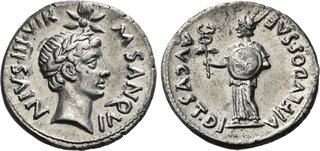| Numismatica Ars Classica > Auction 143 | Auction date: 7 May 2024 |
| Lot number: 478 Price realized: This lot is for sale in an upcoming auction - Bid on this lot  | Show similar lots on CoinArchives Find similar lots in upcoming auctions on |
| Lot description: The Dioscuri Collection. The Roman Empire. Octavian 32 – 27 and as Augustus, 27 BC – 14 AD. Roma M. Sanquinius. Denarius circa 17 BC, AR 19 mm, 3.83 g. AVGVST·DI – VI·F LVDOS·SAE Herald in long robe and feathered helmet, holding winged caduceus and shield decorated with star. Rev. M SANQVI – NIVS III VIR Youthful laureate head of the deified Julius Caesar; above, four-rayed comet with tail. C 6. BMC 70. RIC 340. CBN 273. Very rare and in superb condition for the issue. Light tone and extremely fine Ex NAC sale 84, 2015, 886. Like the preceding coin, this denarius was struck during the period of the restored tresviri monetales under Augustus, in this case by M. Sanquinius, one of the moneyers of 17 BC. In general, the coinages struck by Sanquinius celebrate the ludi Saeculari (Secular Games) held by Augustus in that year and this denarius is no exception. According to Roman Republican religious tradition, every 100 years, special games were to be held to mark the beginning of a new age (saeculum in Latin). In order to ensure that the prestigious ludi Saeculari fell during his reign, and particularly in the tenth year of his power as Augustus, the emperor ordered a consultation of the Sibylline Books. It was, rather unsurprisingly, reported back that an oracle in the books now required the games to be celebrated every 110 years, which made the year of Augustus' decannalia the correct one for celebrating the ludi Saeculares. The emperor dutifully put on a lavish series of games from 30 May to 3 June 17 BC that honoured all of the gods with special rites and included theatrical shows and chariot races. The reverse type depicts one of the heralds that were sent around Rome ahead of the games with orders to invite the people to „a spectacle, such as they had never witnessed before and never would again," according to the Greek historian Zosimus. He carries the caduceus as a sign of his office as herald as well as a shield emblazoned with a star, perhaps representing the dawn of the new age. This star is almost certainly to be connected with the sidus Iulium that appears above the portrait head on the obverse of the coin. The rejuvenated character of the portrait has led to disagreement over whether it is intended to represent Augustus or Julius Caesar, but the sidus Iulium seems to make a strong case for Caesar as Divus Iulius. Indeed, his assassination and supposed ascent to the gods really did mark the beginning of a new age for Rome and the empire. Estimate: 3000 CHF |  |



